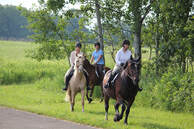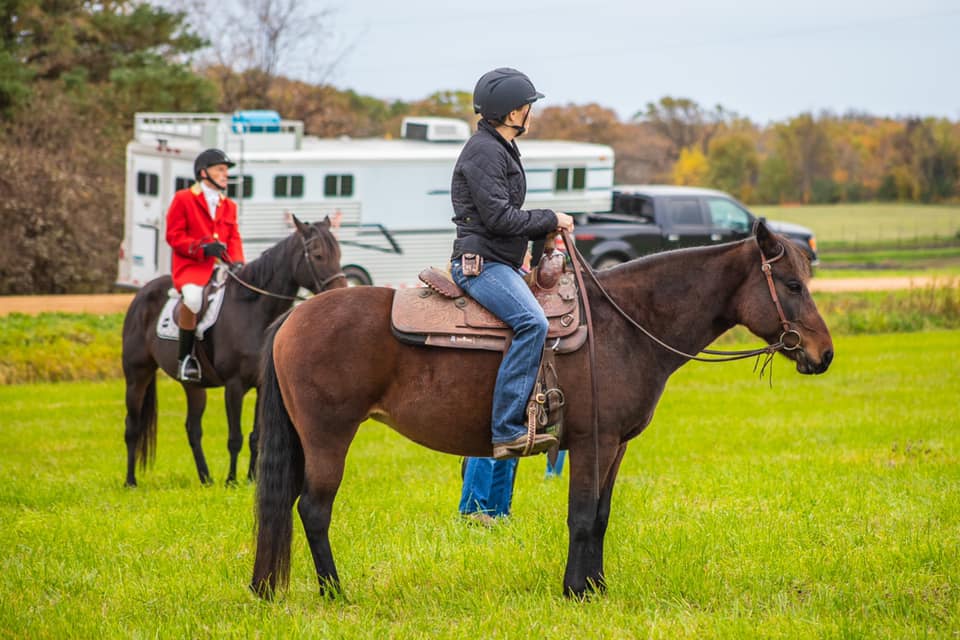Long Lake Hounds welcomes anyone who wants to try hunting, riding any horse, in any saddle. Afterall, we're all out for the same reasons; to enjoy our horses, riding beautiful trails and the laughs that come afterwards!
We do require a couple of things:
• We ask that you let us know that you would like to join us at least 3 days prior to hunting. You can do that be filling out this form. That way we can pair you up with a member who can be your guide for the morning
• Sign a Waiver of Responsibility. If the rider is under 18, this waiver must be signed by parent/legal guardian
• Wear a helmet
• Abide by the rules and etiquette of fox hunting
Children
Children of members are welcome in the field. However, parents are responsible for their safety and conduct. In the event neither parent is present, it is the responsibility of the parents to insure that the child rides with an adult.
We do require a couple of things:
• We ask that you let us know that you would like to join us at least 3 days prior to hunting. You can do that be filling out this form. That way we can pair you up with a member who can be your guide for the morning
• Sign a Waiver of Responsibility. If the rider is under 18, this waiver must be signed by parent/legal guardian
• Wear a helmet
• Abide by the rules and etiquette of fox hunting
Children
Children of members are welcome in the field. However, parents are responsible for their safety and conduct. In the event neither parent is present, it is the responsibility of the parents to insure that the child rides with an adult.
What does a drag hunt look like?
What do I wear?
Function over fashion. In no way will Long Lake Hounds ever not allow someone from hunting because they aren’t dressed correctly. Function first, fashion later. However; a properly turned-out field honors the landowners, shows them we take our sport seriously, and displays the appropriate respect as they watch us ride by.

Summer Season
Dress is casual. Polo shirts with collars, any color except red, that is reserved for the Staff. Helmet is always required.
Dress is casual. Polo shirts with collars, any color except red, that is reserved for the Staff. Helmet is always required.

Formal Season
English riders may wear a black or navy coat, tan or similar breeches, white shirt/stock tie, black dress boots. Western riders may wear a black coat, white shirt, white wildrag or a tie, blue or black jeans, black boots. But function first, fashion later. If you don't have a coat you are encouraged to wear a dark color on top. Helmet is always required.
Guests with colors from other hunts may wear their coat with colors. Gentlemen who have been awarded their colors wear a scarlet coat with white breeches, or black coat, canary vest, white shirt with stock tie, tan, buff or yellow breeches, plain black, waxed calf (Blucher) boots, and helmet with harness. Ladies with colors wear a black coat, canary vest, white shirt with stock tie, tan, buff or yellow breeches, black boots and helmet with harness. Hair should be contained in a hairnet. Please, no earrings other than studs.
On Weekdays during Formal Hunting, it is acceptable to wear “Ratcatcher”, the traditional tweed coat of the foxhunter. This includes a riding coat other than black, shirt with choker, necktie or turtleneck, brick, tan or buff breeches, a helmet with harness, brown or black boots. For additional information on hunt dress, contact the Joint Masters.
English riders may wear a black or navy coat, tan or similar breeches, white shirt/stock tie, black dress boots. Western riders may wear a black coat, white shirt, white wildrag or a tie, blue or black jeans, black boots. But function first, fashion later. If you don't have a coat you are encouraged to wear a dark color on top. Helmet is always required.
Guests with colors from other hunts may wear their coat with colors. Gentlemen who have been awarded their colors wear a scarlet coat with white breeches, or black coat, canary vest, white shirt with stock tie, tan, buff or yellow breeches, plain black, waxed calf (Blucher) boots, and helmet with harness. Ladies with colors wear a black coat, canary vest, white shirt with stock tie, tan, buff or yellow breeches, black boots and helmet with harness. Hair should be contained in a hairnet. Please, no earrings other than studs.
On Weekdays during Formal Hunting, it is acceptable to wear “Ratcatcher”, the traditional tweed coat of the foxhunter. This includes a riding coat other than black, shirt with choker, necktie or turtleneck, brick, tan or buff breeches, a helmet with harness, brown or black boots. For additional information on hunt dress, contact the Joint Masters.
What type of horse do I need?
The key to enjoying a hunt is riding the right horse. This chosen partner makes each ride a special day.
Here are some guidelines to find out if your horse is ready to hunt:
Not sure yet if your horse is ready? We always welcome guests to bring their horses to hound walking. It's a great way to introduce your horse to the hounds in a low stress environment. You can contact Jon Martinson if you would like to walk hounds.
Here are some guidelines to find out if your horse is ready to hunt:
- Will not kick other horses or hounds
- Will stand quietly in a group of horses
- Has athletic ability combined with willingness to listen to the rider
- Is comfortable in woods and open fields
- Will go off on its own without stress
- Is generally more comfortable as a follower than a leader
- Is surefooted to deal with uneven terrain
- Is solidly schooled to gallop and jump over rocky or muddy terrain
- May be any size or breed, ponies to big draft crosses.
- Makes you smile when you walk in the barn each hunting day!
Not sure yet if your horse is ready? We always welcome guests to bring their horses to hound walking. It's a great way to introduce your horse to the hounds in a low stress environment. You can contact Jon Martinson if you would like to walk hounds.
What are the rules of hunting?
We ride at the sufferance of the landowner. Without land there would be no hunt. Please treat others’ land as you would your own front lawn. In Minnesota, much of our hunting is during the crop season. Edge fields unless otherwise instructed. Accordingly, for the general enjoyment of the sport, the safety of riders, horses and hounds, and the fair and respectful treatment of the landowners, we ask members and guests to follow these rules:
- Always be at the meet on time. If hacking to the meet, always come by road to avoid crossing the drag line.
- The Field Master is in charge of the field. The field will follow the Field Master, keeping close behind, but NEVER getting ahead. Riding separately or taking short cuts is forbidden and riders must not straggle behind.
- Your horse: If your horse is a kicker, put a red ribbon on its tail and keep him away from other horses. In the event he kicks and injures another rider or horse, you may be personally liable even though your horse has a red ribbon on his tail. We encourage riders to put a green ribbon on the tail of their inexperienced/green horse. Stay off the heels of the horse in front of you, maintaining a safe distance between your horse and the horse ahead of you at all times. Use the universal signal – a hand behind your back – if the horse behind you is too close.
- Do not cut in front of another rider while approaching a jump. Form a clear and distinct line of approach so there is no question as to whose turn is next. If your horse refuses, go to the end of the line or wait for another suitable opening upon invitation of another field member. Before approaching a jump, wait until the rider ahead is cleared and has gone on. If you choose not to jump, pull out and go to the end.
- In the case of an accident, two volunteers will stay to help the fallen person and a third will ride to notify the Field Master. The rest of the field will ride forward and keep up with the Field Master.
- Never ride between the Huntsman and hounds. Hounds always have the right of way. When staff or hounds are passing, or at a check, turn your horse’s head towards the hounds, keep his heels behind. At a check, or when a cast is made, please be quiet so that the Huntsman will have the full attention of the hounds.
- A raised hand and a call of “Hold Hard!” requires you to stop where you are, stand still and be quiet. When you see a hazard, such as a hole or wire, point to it and pass the warning back by saying “ware hold,” “ware wire,” or whatever is appropriate.
- If you find a gate open, leave it open. If it’s shut, please shut it. Any questions, ask the Field Master. When a rider dismounts to open or close a gate, or to lower or fix a fence, a rider shall remain with the dismounted person. Be sure wires are replaced over gates or jumps. Report all damages to crops or fences immediately to the Field Master.
- Never gallop past a fenced field of horses or a herd of livestock. If you see anything out of order regarding livestock, report it to the Field Master immediately.
- When crossing a road, the whole field should do so simultaneously.
- Do not block roads with vans or trailers. All vans and trailers must be parked on the same side of the road, over as far as possible to accommodate school buses and emergency equipment.
- If you need to leave the meet early, or wish to change fields, please let the Field Master know. If you leave early, the Field Master may wish to direct you so that you will not interfere with hunting or cross the line on your way home.
- The Masters, Board of Directors and Staff of the Long Lake Hounds are always concerned about the safety of the Hunting Field. Any rider may be requested to leave the field at any time by either the Masters or the Field Master if, in their opinion, the safety of the field is endangered.
- At the conclusion of the Hunt, please wait to be excused by the Masters before leaving for your trailer. If hacking home, walk your horse until you are well away from the meet.
Can I become a member?
Yes! We are always welcoming new members. There are several different levels of membership. Click here to view the different options.






